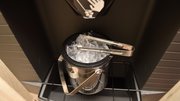Blog
Lets Go On With The Show
June 15, 2015 by Tim Sanford
TAGS: Vending Times editorial, vending industry, vending editorial, retail automation, vending operator, vending industry history, coin machine, micro markets, coffee service, food service, Tim Sanford, NAMA OneShow, National Automatic Merchandising Association annual trade show, OneShow first-time exhibitors, Internet of Things |
The full-line vending revolution was the Next Big Thing in the late 1950s and early '60s. The explosive growth of a new industry that uniquely met the need for round-the-clock service in large workplaces attracted a great deal of attention, and its demand for prewrapped single-serving products touched off a prolonged period of innovation in format and packaging of confections, snacks and convenience foods.
I joined Vending Times just as that early impetus was subsiding because of market saturation and incipient industry maturity. We had a mental image of a spotlight illuminating one promising new industry after another. As we watched, the beam moved from vending to fast-food restaurants, which became the next Next Big Thing. By that time, though, the industry had developed a momentum of its own.
With those memories, we were very pleased by this year's National Automatic Merchandising Association annual trade show, now called OneShow. The presence of 75 first-time exhibitors suggests that the workplace refreshments industry is attracting attention once again. That is a very positive development, fueled by the growing recognition that vending machines -- and micromarkets -- are excellent media for interacting with the public, and also have moved into the vanguard of the "Internet of Things" as operators strive for greater precision and speed in matching products to patrons while streamlining route service and inventory management expenses.
It also suggests that the role of trade shows in building industry awareness and promoting sales is being recognized to a greater extent than it has been in recent years. There seems to be another imaginary spotlight at work in this area too; it would be fun to track the cyclical fortunes of trade shows over the decades.
Be that as it may, the rebound of interest in exhibiting products and services at OneShow is a positive development in its own right. We've argued that effective selling requires a variety of tools; and, while the Internet has added attractive new techniques, it certainly hasn't superseded all the earlier ones. The Internet does an outstanding job of pointing you to an item you want and taking your order. A trade show is vastly superior for finding an item that you will want, once you discover that it exists. And walking around something of interest while talking to someone who knows all about still is the most satisfactory way to get the information you need for a purchase decision.
Another major benefit of a trade show is that it can support industry-specific education, and the NAMA annual convention always has done this very well. In addition to the formal programs, just walking through the exhibit area and speaking with operators and suppliers is educational in a way nothing online can match.
The traffic at this year's exhibit was as heavy as we've ever seen it. One exhibitor remarked, on the last day of the show, that he had experienced the usual first-day rush -- and it never let up. Much of the reason for this is that the torrent of new equipment, products and services has increased the need for the sort of informative face time that only can be satisfied by a trade show. The addition of so many new exhibitors has increased that need.
It is worth pointing out that the trade shows of four and five decades ago were not characterized by a large number of exhibits. Prior to the gradual but vast changes caused by the adoption of glass-front multiÂproduct merchandisers (after 1973) and the steady improvement of payment systems, the range of vendible products was much narrower. There were very few real management solutions available before ways were found to make computer systems available to small businesses (in the mid- to late '70s). Thus, the 1975 NAMA convention's exhibit featured some 170 manufacturers and suppliers. The real boom in trade shows began in the next decade.
But the 1975 show offered visitors 21.5 hours of exhibit viewing, while the 2015 OneShow provided 14.5 hours. If a 1975 showgoer wished to stop at every booth, he or she would have had more than 7.5 minutes to devote to each, compared with about three minutes this year.
Differences of opinion about ideal exhibit hours are an inevitable concomitant of trade shows. It can be argued that there are many more sources of information available today (especially the Internet), and a visitor who sees something interesting can do a good deal of research into it without spending as much time in the booth as would have been needed even at the turn of the millennium. It also is true that the amount of time devoted to education is very much greater than it was four decades ago. Just the same, we think some thought might be given to extending exhibit hours.
One intangible benefit to attending trade shows is that it strengthens industry affiliation. Most people are heartened by speaking with others who confront the same challenges and perceive similar opportunities. That benefit remains as valuable now as it ever has been, and it was much in evidence at the 2015 OneShow.







